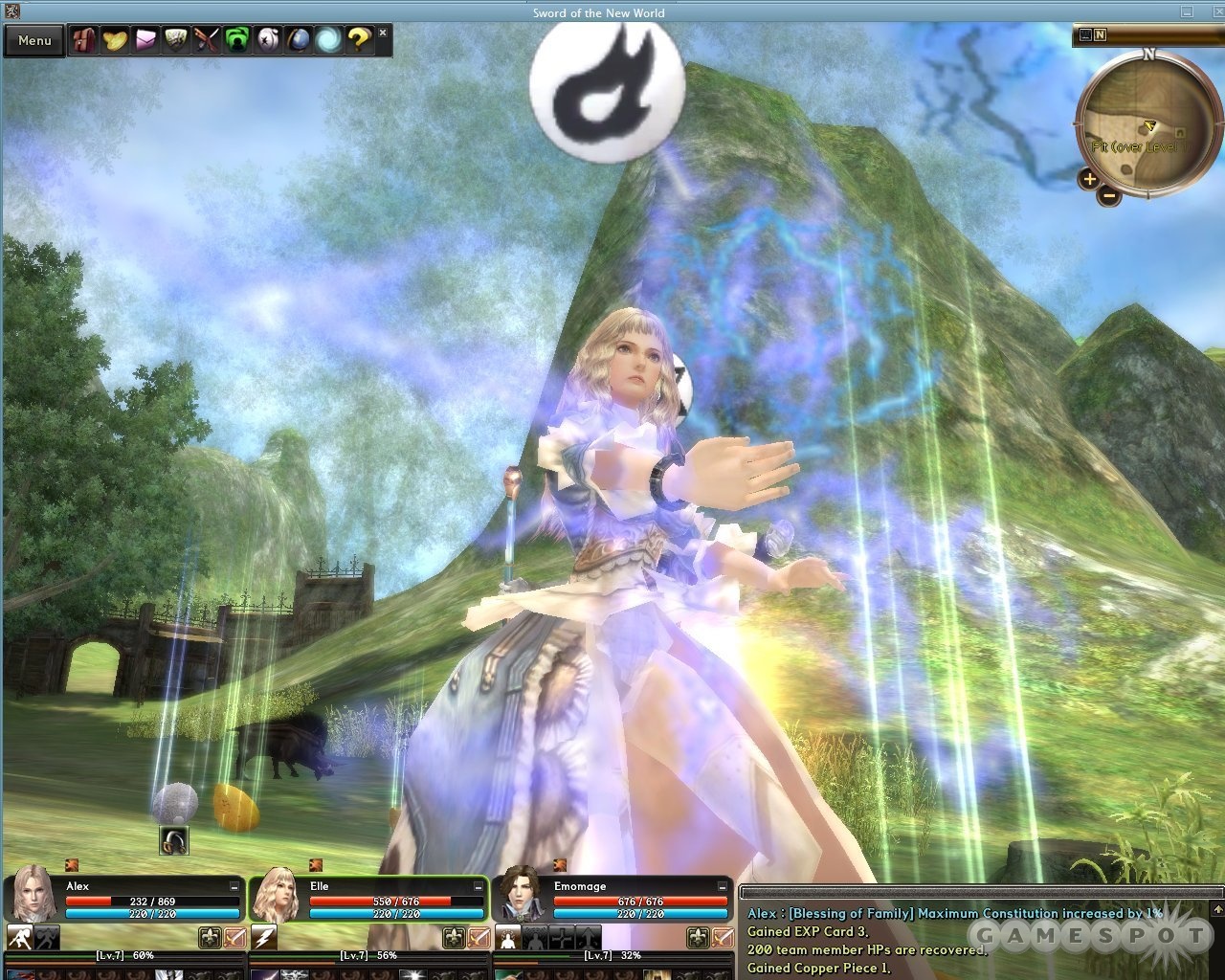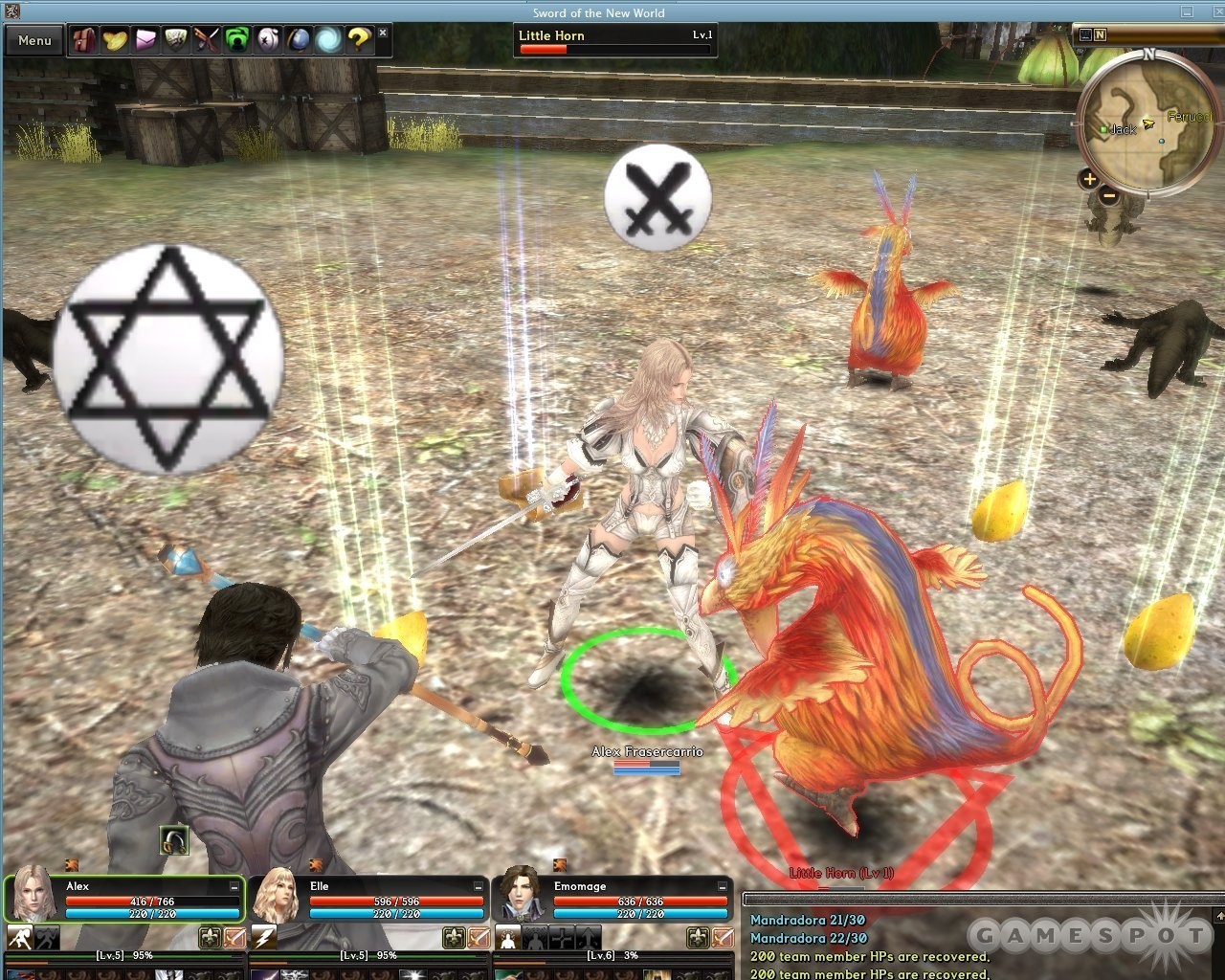One thing's for sure--Sword of the New World: Granado Espada won't waste anybody's time. This new massively multiplayer online game from Korean developer K2 Network is all about grinding away at killing monsters and gaining levels from the very moment that it begins. Despite interesting design twists and an offbeat storyline blending swords and sorcery with the colonization of a fantasy-tinged new world, the game collapses under the sheer weight of its monotonous gameplay.
Story and setting are arguably the most intriguing lures, and certainly what makes the game stand out the most from the MMO crowd in the beginning (that and the innovative pricing model that scraps monthly subscriptions for a Free2Play system bolstered with cash shops for in-game items). The plot mashes together a number of historical themes to create a unique whole featuring elements of the age of discovery, medieval fantasy, and foppish Victoriana. Added elements like a budding civil war between Royalist and Republican factions and a religious feud between the mainstream church and the new faith of Solioto even establish something of a real-world political backdrop. Still, K2 doesn't make the most out of this setting. The politics aren't pronounced enough to have much of an impact on your actions, and might as well not really even be there in the first 20 levels or so. Also, window-dressing NPCs and weird translation issues make your dealings with people a bit surreal. Typos are common, as are NPCs who respond to conversation attempts with apropos-of-nothing retorts like "Sounds good!" or pure nonsense such as "These good chances are not always like this!"

K2 also doesn't do much with character design, despite intriguing ideas. Although the game is built off the neat notion of creating a noble family and adventuring through the new lands of Granado Espada in teams of three, there isn't any depth when it comes to the creation of the individual characters. There are only five different stock-standard classes offered at the beginning (although bonus classes are available with boxed versions of the game, and additional ones become available upon the completion of quests). You've got a warrior, a wizard, a sort-of wizard called an elementalist, and a scout representing the D&D crowd, along with a musketeer to add a pinch of "age of discovery" atmosphere. Few options are available to customize your selections aside from a handful of costumes. There are no ways to alter faces, hair color, body frame, or anything else until you get into the game and start collecting new armor, weapons, and other accoutrements, although the addition of new combat stances unique to each class helps.
Quests are equally simple-minded. The first dozen or more hours of play is a grindfest in which incessant monster-killing is solely spiced up by the odd delivery or pick-up assignment (which typically involves wandering around aimlessly and killing monsters anyhow, given that key quest locations sometimes aren't marked on the map or represented in the game world). The amount of time you have to devote to mindless slaughter is somewhat incredible. One of the first big quests involves acquiring trophies by exterminating three different types of monsters prowling around an old monastery. That sort of assignment is par for the course in the early stages of MMOs, of course, but the numbers involved here are just staggering: you have to slay between 150 and 200 of each creature. Add in a slow respawn rate, and regularly cooling your heels for a minute or more after getting overwhelmed by swarms of ghouls and other critters, and you've got a quest that takes upwards of three hours to complete. This seems pretty representative of Sword of the New World as a whole. All of the jobs seen up to about level 20 require a mind-numbing amount of killing, involving hundreds and hundreds of endlessly respawning beasties.
Other problems afflict this eternal combat. Battles typically involve so many monsters that you need to team up with others to survive, even though the three-person team idea would seem to have been introduced here for the sole purpose of giving players the ability to go solo. The monster menagerie reuses the same creatures with only slight modifications to make them look a little different. So even though you do get to kill bizarre beasties like demonic roosters and hunchbacked gnomes called vedonabahs, you're generally wading through packs of three or four monster types in each map. A lot are just slight variations on fantasy stereotypes with odd new names. What appear to be skeleton warriors, for instance, are called zealots, while giant spiders are known as zebra-eaters.
These battles with interminable numbers of monster clones also run on rails, giving the action an assembly-line feel. Unless you intervene, your characters automatically attack enemies that get too close or that stand in the way of quest destinations. You can actually leave the room for stretches and let the game play itself, especially during the monster-massacring quests. And just getting to the average quest location is a challenge all on its own. Soldiers and waypoints provide instant teleportation for a nominal fee, but even when you take advantage of this transit system, you still have to wade through a few lengthy maps packed with respawning monsters on the way to each quest.
Getting killed is a regular fact of life in Sword of the New World. It's also a major pain, because you respawn in the exact same location where you were killed, only with your hit points halved. So you can expect to pop back to life in the midst of the murderous horde of monsters that just offed you a moment ago, and with far fewer hit points available to withstand round two. Often, you're in even worse shape because your three characters were killed at different times, meaning that they respawn one-by-one as cannon fodder. This means that getting killed once pretty much guarantees getting killed at least three or four times. About the only way to deal with this is to hope that the first couple of slain enemies drop health-boosting mangoes right away, giving your solo adventurer a chance at surviving long enough for his or her buddies to join up again. A better idea, though, is running like hell as soon as one character wakes up and praying that the others survive to follow you to a relatively safe spot, like a corridor populated with only a dozen or so baddies.
Combat rewards don't give you any incentive to endure such frustrations. Enemies frequently drop those health mangoes, but little in the way of cool swords, guns, or magical artifacts. You have to expect the award of nifty gear to be spread out well in an MMO, but K2 gives you almost nothing of note through the opening 20 levels or so, aside from the occasional mediocre sword or mage's staff. Additionally, the icons representing all these items aren't very distinct, so it's hard to tell what you should stop and pick up without hovering the cursor over them for the tool-tips. Incidentally, the same issue occurs in the interface after you've added items to your inventory; tiny, nearly identical icons are used for many different types of gear. This makes sorting through your options when kitting out your adventurers an awfully tedious chore. Incidentally, you do have the option to go in and buy some better loot using real money in the game's shop, and these items there are a bit of an improvement over the standard loot. It's just highly questionable as to whether they're good enough to warrant the added cost.
Art design is Sword of the New World's one standout attribute, and you can't even applaud it without some reservations. Everything is extremely fancy. You wander through Renaissance-era towns, accept quests in ornate Edwardian drawing rooms, delve into tiled-floor dungeons, and slaughter monsters in lush, green forests. Granado Espada seems more like a vacation resort than an uncivilized New World waiting to be explored, although the picturesque settings don't mesh with the notion that you're involved in the settling of a new frontier. If anything, most of the towns here look so old and prosperous that you might think that they've been established for centuries.

Elaborate, foppish costuming adds to the rich atmosphere. Character outfits for men tend to feature lacey coats with tails, and outfits for women boast plunging necklines and high-cut hemlines. So the guys generally look a lot like metrosexual butlers, and the gals resemble riverboat prostitutes. The kink factor is so pronounced that female attire resembles fetishwear. One opening outfit choice is nothing more than a schoolgirl uniform. Another frilly number is cut so low in front and so high down below that the wearer is constantly on the verge of popping out of it and flashing crotch shots whenever you zoom in for a combat close-up. Bouncing breast animation adds to the tease, and there is so much running from one place to another in the game that you constantly recreate the finest moments from Baywatch. Toss in poses during battle that come straight out of Charlie's Angels and you can readily see that K2 has aimed this one at the geek-boy crowd.
Sound effects are all over the place. Combat is accentuated by the usual metallic ringing of swords against armor and the whoosh of magical spells, although everything sounds tinny. Furthermore, there are no voice samples aside from quickie click-on comments like "Is this the right way?," which only serve to let you know that there are people in those odd outfits. Music is just as bizarre as the costuming. One moment you're in a town listening to an ornate aria or a classical piano piece; the next you're doing battle to a disco score that transports you to Dance Central in Stuttgart. You never know what you're going to get when you enter a new area. A dungeon could feature chamber music, offbeat choral odes in a foreign language, jaunty notes reminiscent of the techno-jazz in the original Sonic the Hedgehog, or all three mixed together. The one positive about these dramatic changes in musical tone is that they mix things up quite a bit. The big negative, however, is that all of the featured pieces are amazingly obnoxious and repetitive. This game is in desperate need of more subtle tunes.
It's hard to imagine anyone choosing to endure this sort of monotonous gameplay for very long. The price may be right, and there is certainly something hypnotic in the combination of the non-stop killing and way-out music, but you'll still soon wake up to the reality that Sword of the New World is an endless onslaught of hacking-and-slashing.